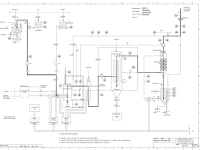Plasma treatment of a slurry with a content of environmentally hazardous materials
Milan Korostenski (millekoro@gmail.com w1521)
Justification
Plasma treatment is a process suitable for treating environmentally hazardous sludge/slurry fluids. Plasma is suitable for the final step in the treatment of evaporator sludge. It is also useful for the treatment of effluents from the pharmaceutical industry, processes that include hazardous chemicals, leaking landfill sites and nuclear power plants. In addition, the plasma treatment can be used to combust spent ion-exchange resins, and it destroys chlorofluorocarbons (CFC).
The treatment process has been tested in full scale and is ready to be introduced on the market. The process has been patented.
Process description
The plasma treatment process can treat all kinds of slurries that can be pumped and metered. They may contain organic and inorganic materials in the liquid and solid phases, including salts. The plasma oxidizes the treated materials into oxides. Gaseous oxides react with each other and three kinds of products are formed. Gases such as carbon dioxide are released to the atmosphere after washing and filtering. Glass compatible oxides form a glass phase. After cooling the glass phase consists of a monolith that can be disposed of. Usually the glass phase includes the heavy metals that may have been present during the treatment. Oxides that are not compatible with a glass phase are separated as salts, often as common salt. The end product can be stored as the monolith, powder or pellets/gravel.
Capacity
100 liters of slurry per hour, circa 2.5 m3 of slurry per day. Dry matter content 10–15%.
Origin of the process
The process was developed in cooperation with the company ScanArc AB in Hofors, Sweden. ScanArc has specialized in plasma for industrial applications. The Vattenfall Research & Demonstration program for the nuclear power units in Forsmark paid for development, about 1.5 million US dollars over five years. The process has been successfully tested in full scale in the research laboratory of ScanArc in Hofors. At present, the relevant parties are not planning to build a process plant. The estimated cost of construction is about 1–1.5 million US dollars, for nuclear power applications 5–6 million US dollars.
The author's presentation
Milan Korostenski worked for Asea Atom AB (1972–1983) as process designer. The company delivered the complete BWR nuclear power plants in Sweden and Finland. During the period 1983–2010 he worked as a process chemistry specialist in Forsmark. After retirement, he works as a consultant for the company Faveo AB.
Also see LinkedIn.
References
Patent WO 2011136727 A1
Sven Santén (ScanArc AB; Technical Director) mail@scanarc.se
Thomas Larsson (Forsmarks Kraftgrupp AB, Waste Treatment) etl@forsmark.vattenfall.se
Ingvar Carlsson (Forsmarks Krafgrupp AB, Chemistry) ica@forsmark.vattenfall.se
For orientation see also
Vattenfall AB http://corporate.vattenfall.se
Forsmarks Kraftgrupp AB http://corporate.vattenfall.se/om-oss/var-verksamhet/var-elproduktion/forsmark/forsmark
ScanArc Plasma Technologies AB http://www.scanarc.se
SKB http://www.skb.se
Like this entry?
-
About the Entrant
- Name:Milan Korostenski
- Type of entry:individual
- Patent status:patented








